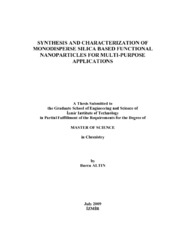Please use this identifier to cite or link to this item:
https://hdl.handle.net/11147/3375Full metadata record
| DC Field | Value | Language |
|---|---|---|
| dc.contributor.advisor | Özçelik, Serdar | - |
| dc.contributor.author | Altın, Burcu | - |
| dc.date.accessioned | 2014-07-22T13:51:24Z | - |
| dc.date.available | 2014-07-22T13:51:24Z | - |
| dc.date.issued | 2009 | - |
| dc.identifier.uri | http://hdl.handle.net/11147/3375 | - |
| dc.description | Thesis (Master)--İzmir Institute of Technology, Chemistry , İzmir, 2009 | en_US |
| dc.description | Includes bibliographical references (leaves: 81-84) | en_US |
| dc.description | Text in English; Abstract: Turkish and English | en_US |
| dc.description | xiii, 84 leaves | en_US |
| dc.description.abstract | The Stöber method was performed to tune the size of monodisperse silica nanoparticles in the range of 10 to 500 nm. It was observed that increasing amount of reactants favors the formation of larger particles A Stöber method in the presence of L-lysine as a catalyst instead of ammonia was developed to prepare well-ordered, highly monodisperse silica nanoparticles based on the hydrolysis and condensation of TEOS. The effect of medium temperature, amounts of L-lysine, TEOS, octane and dye on the size of particle was investigated. It was found that L-arginine increased the size of particles. The amount of TEOS was determined to be 50.0 mmol to obtain the smallest size of particle. The mole of L-lysine slightly altered the size of particles, however the surface of particles was substantially covered by L-lysine. The presence of octane does not change the size of particles. The amount of dye molecule Rhodamine B isothiocyanate (RBITC) does not alter the size of nanoparticles. We showed that temperature plays important role tuning the particle size from 5.0 nm to 80.0 nm.MTT assay indicates no cytotoxicity of the silica particles against MCF-7 (human breast cancer cell lines) and PC-3 (human prostate cancer cell lines) cancer cell lines. The particles enter to the cells within 5 minutes with a concentration of 0.1.g/mL. We propose that these particles can be used in the field of bioimaging and drug delivery. | en_US |
| dc.language.iso | en | en_US |
| dc.publisher | Izmir Institute of Technology | en_US |
| dc.rights | info:eu-repo/semantics/openAccess | en_US |
| dc.subject.lcc | TP248.25.N35 .A46 2009 | en |
| dc.subject.lcsh | Nanoparticles | en |
| dc.subject.lcsh | Silica | en |
| dc.subject.lcsh | Nanostructures | en |
| dc.title | Synthesis and Characterization of Monodispere Silica Based Functional Nanoparticles for Multi-Purpose Applications | en_US |
| dc.type | Master Thesis | en_US |
| dc.institutionauthor | Altın, Burcu | - |
| dc.department | Thesis (Master)--İzmir Institute of Technology, Chemistry | en_US |
| dc.relation.publicationcategory | Tez | en_US |
| dc.identifier.wosquality | N/A | - |
| dc.identifier.scopusquality | N/A | - |
| item.openairecristype | http://purl.org/coar/resource_type/c_18cf | - |
| item.languageiso639-1 | en | - |
| item.openairetype | Master Thesis | - |
| item.grantfulltext | open | - |
| item.fulltext | With Fulltext | - |
| item.cerifentitytype | Publications | - |
| Appears in Collections: | Master Degree / Yüksek Lisans Tezleri | |
Files in This Item:
| File | Description | Size | Format | |
|---|---|---|---|---|
| T000824.pdf | MasterThesis | 4.06 MB | Adobe PDF |  View/Open |
CORE Recommender
Page view(s)
202
checked on Mar 31, 2025
Download(s)
136
checked on Mar 31, 2025
Google ScholarTM
Check
Items in GCRIS Repository are protected by copyright, with all rights reserved, unless otherwise indicated.